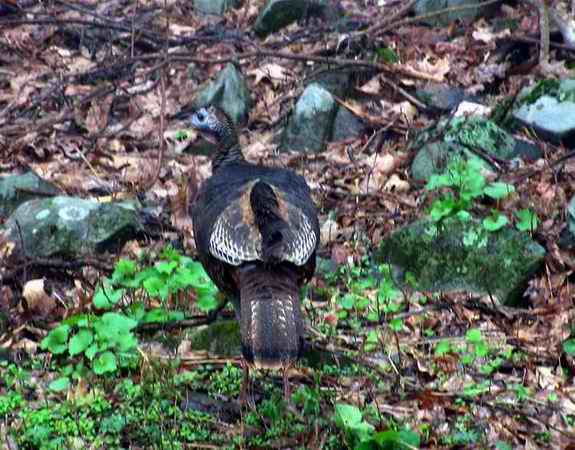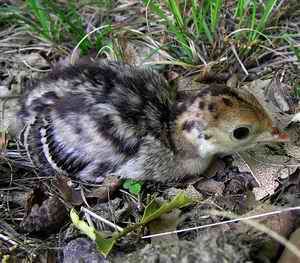|
Return to Hiker's Notebook Home Page
Common Name: Wild Turkey - The common name is a misnomer. The bird of North American origin resembled the turkey-cock, a domesticated bird native to West Africa now known as a Guinea fowl; "turkey" was widely applied as a descriptor for anything that originated in the Islamic (Turkish) lands of Africa.
Scientific Name: Meleagris gallopavo - The generic name is the Greek word for the Guinea fowl, a bird native to West Africa (Numida meleagris) that has been domesticated in many parts of the world. The specific name is a combination of the Latin words for cock (gallus) and peacock (pavo).
The turkey that epitomizes the bounty for which our thanks giving is celebrated was domesticated from the wild turkey. The Spanish conquistadores who conquered the Aztecs early in the 16th Century found both wild and domestic turkeys, so it is presumed that they were first domesticated in Mexico. Cortez is generally credited with the introduction of the turkey to Spain; they subsequently spread to the rest of Europe. The bird from the Americas was first given the common name turkey in England because of its similarity to the turkey-cock, a bird that was already widely domesticated. The turkey-cock was the colloquial name for the Guinea fowl, a bird that is native to the Guinea coast of West Africa. The name turkey-cock was applied to the Guinea fowl because it originated in the Islamic lands, which were referred to with the synecdoche "Turkey," a descriptive name commonly associated with commodities from outside Europe. The domesticated Spanish-American bird known as the turkey was reintroduced to the North American English colonies in the 17th century. When the colonists discovered that there was a similar wild native bird, it came to be known as the wild turkey.
The turkey was introduced to Europe from origins considered obscure and exotic; its circuitous journey from North America to Europe was likely outside the comprehension of most of the populace. Its names in other languages accordingly bear testimony to a tempestuous etymology. In France, the turkey was called poulet d'inde, or chicken from India, which over time became dindon. It is also assigned an Indian provenance in Turkey, where it is known as hindi, which means "from India," and in Israel, where it is known as tarnegol hodu, "Indian chicken." Interestingly, hodu is a homonym for the Hebrew word for thanks, thus suggesting that the turkey was the "thanksgiving chicken." The Dutch (kalkoen) and Nordic (kalkun or kalkon) names for the turkey are all variations on the city of Calcutta in India. In Portugal, it is called peru, presumably to reflect Peruvian origins. The Greek turkey is gallopoula, meaning "French chicken."
There are two species of wild turkey, the North American wild turkey and the Central American wild turkey (M. ocellata), the latter being smaller with a blue head, and brighter plumage. The species name is Latin for "little eye" (ocellated means spotted in English) in reference to the peacock like markings on its tail feathers. There is some speculation that the ocellated turkey may have been domesticated by the Mayans; however, it is not the forbear of the domestic turkey, as it lacks the prominent breast tuft or beard that is a characteristic of both the domestic and North American wild turkeys. M. gallopavo is a large ground-dwelling bird with short wings, a long fleshy dark and iridescent plumage, prominent leg spurs and either a blue, red, or white head, according to its emotional state. The changing colors of the head are probably one of the reasons why the Japanese call the turkey shichmencho or bird with seven faces. This is based the belief that the turkey changes its facial expression in concert with its emotional state.
There was a curious relationship between the wild turkey and Native Americans. Turkeys were considered by some Indian tribes to have spiritual significance; turkey feathers were an important part of ceremonial ornamentation and were incorporated into articles of clothing and headdresses. However, they were not widely exploited as a source of food, serving as such only during lean winters when other game was scarce. A measure of the competence of the Indians as hunters may be appreciated by the fact that they considered the turkey to be fitting prey only for children, who developed a ritualistic hunting regimen. The birds were first attracted by the simulated sound of the gobbling noise of the male bird made by blowing through a hollowed-out turkey wing bone. The attracted flock was then chased until the individual birds were dispersed to the trees, where they were sequentially and inexorably dispatched with arrows. Ironically, the arrows were used to kill the turkeys may well have been made with points fabricated from the foot spurs of older male turkeys and guided by turkey feathers that had been fletched onto the wooden shaft.
Turkeys were abundant in colonial America. Flocks of hundreds of thousands of birds were reported by numerous observers in the late 18th and early 19th Centuries. One of the primary reasons for their profligacy was that there were large tracts of open woodland, their ideal habitat. Contrary to the caricature perpetuated in legend and literature, the Native American of the eastern forests did not live in harmony with nature, allowing it to take its course without human intervention. They regularly and routinely burned the forest to clear out undergrowth to create grasslands. In the book "1491," author Charles Mann concludes that "rather than domesticate animals for meat, Indians retooled ecosystems to encourage elk, deer, and bear." Adriaen van der Donck, one of the first settlers of the Hudson River Valley, wrote that the Haudenosaunee Indians set fire to the woods every fall to clear them "of all dead substances and grass, which grow better the ensuing spring." Since the Indians did not hunt them extensively and the habitat was maintained for their propagation, the wild turkey population was in the millions. This all changed with the westward expansion of European civilization.
Unlike Native Americans, Colonial Americans had no spiritual association with turkeys and no convictions concerning the simplicity of the hunt. They accordingly dispatched wild turkeys at a rate of as many as a hundred birds a day which were sold at a price of about 25 cents a piece in the eastern markets. The turkey's woodland habitat was also extirpated as homesteads proliferated with their concomitant clearing of the land for crops. By the early 20th Century, the wild turkey had disappeared from a large portion of its former range and was at some risk of extinction. The Federal Aid in Wildlife Restoration Act of 1937 initiated long needed reforms, including the regulation of hunting, the establishment of preserves, and active breeding programs to restore the turkey population to resilience. Wild turkey populations are now healthy.
Wild turkeys travel in small single-sex flocks for most of the year. They are
diurnal and omnivorous, traveling through the woods in search of food that
includes everything from acorns and clovers to spiders and small snakes. At
night, they roost in trees, generally over water if available to avoid
predation. They have very good eyesight and can move with surprising celerity
both on the ground and in the air; they can fly at speeds of up to 55 miles
per hour for short periods and they can run at speeds up to 18 miles per
hour. In the early spring the flock pattern changes as the polygynous males
seek to attract females to form a harem of sorts. This is accomplished
|

 with
instinctual alacrity as the male struts about with his tail extended emitting
the characteristic gobble sound, one of 15 recognized turkey vocalizations.
Breeding follows the gathering of the female flock and the hens lay from 4 to
17 eggs in a nest that is usually only a shallow depression in the ground.
After about 30 days of incubation, the young turkeys or poults hatch; they are
precocial and can therefore walk and feed themselves after about 24 hours.
Turkeys are parthenogenetic; they can reproduce asexually. This unusual
characteristic probably evolved as a survival tactic; the resultant poults are
almost always male and are generally unhealthy.
with
instinctual alacrity as the male struts about with his tail extended emitting
the characteristic gobble sound, one of 15 recognized turkey vocalizations.
Breeding follows the gathering of the female flock and the hens lay from 4 to
17 eggs in a nest that is usually only a shallow depression in the ground.
After about 30 days of incubation, the young turkeys or poults hatch; they are
precocial and can therefore walk and feed themselves after about 24 hours.
Turkeys are parthenogenetic; they can reproduce asexually. This unusual
characteristic probably evolved as a survival tactic; the resultant poults are
almost always male and are generally unhealthy.